I’ve been a WordPress blogger since 2021, and from day one I wanted to optimize my site without spending much. That’s how I discovered RankMath, a free SEO plugin for WordPress that feels like a Swiss Army knife for SEO. RankMath’s free plan replaced the need for multiple plugins (sitemaps, meta editors, schema, redirects) and kept things simple for this beginner. In fact, among all free SEO tools for WordPress I’ve tried, RankMath Free offers the most bang for your buck. Even today, I rely on RankMath free to handle everything in one place.
Google search is now using AI Overviews (smart snippets) that show a quick answer above the normal results. If you’re wondering how to show in Google AI overviews, the answer is good content structure with schema markup. RankMath Free makes this easy: I add FAQ and HowTo schema blocks to my posts, which helps Google understand my content better. For example, if I write an article “How do I start a blog?” and include FAQ schema, Google might display my questions and answers right in the search results. This snippet is exactly an example of how to show in Google AI Overviews, taking up more space on the page and building trust, which can lead to more clicks.
Overall, using the best SEO plugin for WordPress since 2021 has helped my blog grow even without paying for Pro. My site traffic was slow at first like planting seeds in dry soil but by sticking with this free SEO workflow and consistently publishing content, growth began to sprout. Those small efforts (like adding schema and building a clear site structure) were like giving my plants extra sunlight and they grew stronger in search results. Consistency and helpful content matter more than chasing shortcuts. If you follow these steps and focus on one topic per post, results will follow.
Table of Contents
Getting Started: Download and Install Rank Math Free
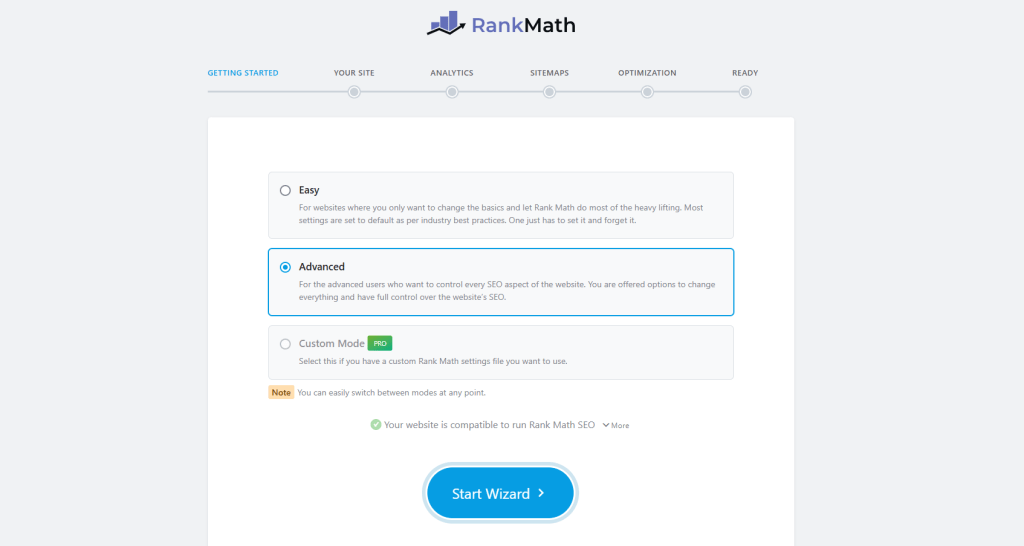
- Install the Plugin: First, go to the official Rank Math site [Link to official Rank Math site] or search for “Rank Math SEO” in your WordPress dashboard. Click “Get Started Free” to download the plugin ZIP file (your RankMath download is completely free). Then in your WordPress dashboard go to Plugins → Add New → Upload Plugin, choose the ZIP file, and hit Activate. The free plan includes all essential features (SEO analysis, schema markup, sitemaps, Search Console integration, on-page tools) at no cost. In other words, you now have a powerful free SEO plugin for WordPress installed on your site.
- Run the Setup Wizard: After activation, RankMath will launch an initial setup wizard. Choose an SEO mode (Easy, Advanced or Custom) based on how much control you want. I usually pick the Easy mode first. Connect your (free) RankMath account to unlock more features and link Google Analytics/Search Console if you have them. Fill in your site information (site type, logo, social profiles) as prompted.
- Connect Google Search Console: This step is critical. Linking RankMath to Google Search Console lets you see your keyword impressions and clicks right in WordPress – no more hopping between tabs! To do this, go to RankMath’s Dashboard under General Settings → Webmaster Tools, and follow the steps to authorize Google Search Console. Once connected, you’ll get free data on how your pages are performing. (If you want more detailed analytics, RankMath Pro offers built-in rank tracking, but for me the free data covers the basics.)
My Rank Math Free Workflow: Step by Step
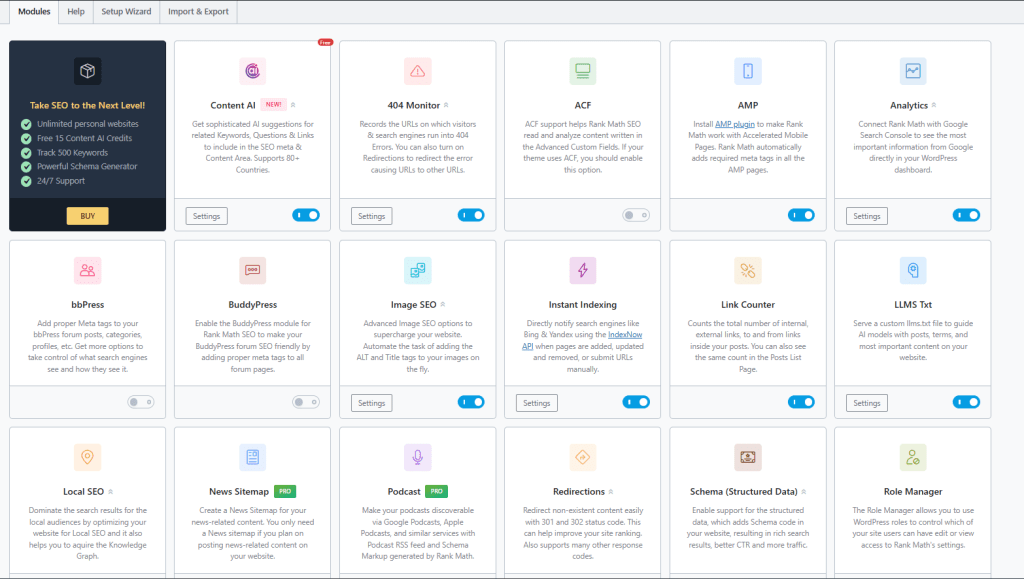
I keep my RankMath setup light and focused. Turn on only the modules you need and disable the rest. This keeps WordPress fast and uncluttered. Here’s my step-by-step workflow using RankMath Free:
- Enable Essential Modules: In the RankMath dashboard (Modules section), switch on the modules I use: for example, Sitemap, Schema, Redirections, Image SEO, 404 Monitor and SEO Analysis. These cover the key SEO tasks. RankMath’s modular setup means you don’t have to use everything but to pick what matters. By choosing only these free SEO tools for WordPress within RankMath, I keep my site lean and efficient.
- Disable Unneeded Modules: Any features I don’t use, I disable. For instance, if I’m not running an online store or podcasts, I turn off those modules. This makes WordPress load faster. (Pro Tip: review your modules every few months. If your site needs change, you can always turn a module back on later.)
- Optimize Images (Auto ALT Text): I use RankMath’s Image SEO feature to save time. When I upload images, RankMath can auto-add ALT text based on the file name or your settings. This improves accessibility and helps images rank in Google Images. Before uploading, I give images descriptive file names (e.g. blue-mountain-biking.jpg), because RankMath will use that to generate ALT text. This little step ensures all images boost SEO without manual edits.
- Manage Redirects: Instead of adding another redirect plugin, I use RankMath’s built-in Redirection Manager. Here I set up 301 (permanent) or 302 (temporary) redirects any time I delete or move a post. That way neither visitors nor search engines hit a dead end. (Tip: After adding a redirect, I always test it to make sure it points correctly. This avoids losing any SEO value.)
- Generate and Submit XML Sitemaps: RankMath automatically builds an XML sitemap for your site. I submit this sitemap to Google Search Console so Google can crawl my site faster. The sitemap lists all your pages and posts, which helps Google find new content. (You can also control what’s included via the RankMath settings, but the defaults usually work well.)
- Set Canonical URLs: To avoid duplicate content issues, I use RankMath to set canonical tags on each post. That tells Google which URL is the “main” one for that content. If you have similar pages or category archives, canonicals prevent confusion. RankMath often auto-sets them, but you can adjust the canonical URL in the post editor if needed.
- Monitor 404 Errors: Under RankMath → Redirections → 404 Monitor, I keep an eye on broken links. Fixing 404 errors quickly ensures users aren’t lost and that no broken links hurt SEO. RankMath logs any 404 hits, so you can easily redirect those pages to the right content and preserve link value.
- Assign Schema Markup: In each post or page, I choose a schema type (Article, FAQ, HowTo, etc.) that best fits the content. Schema is structured data that helps Google understand your content. For example, if it’s a tutorial, I pick “HowTo”; if it’s an informational post, I use “Article.” (RankMath Free allows one main schema type per post, but it has handy FAQ/HowTo blocks you can add.
Each of these steps is optional, but I focus on those that really help. For example, I don’t stress about the Content AI suggestions in RankMath Free, it’s not essential for me. The basics of on-page SEO, structure, and schema get the job done.
Optimizing Posts and Pages
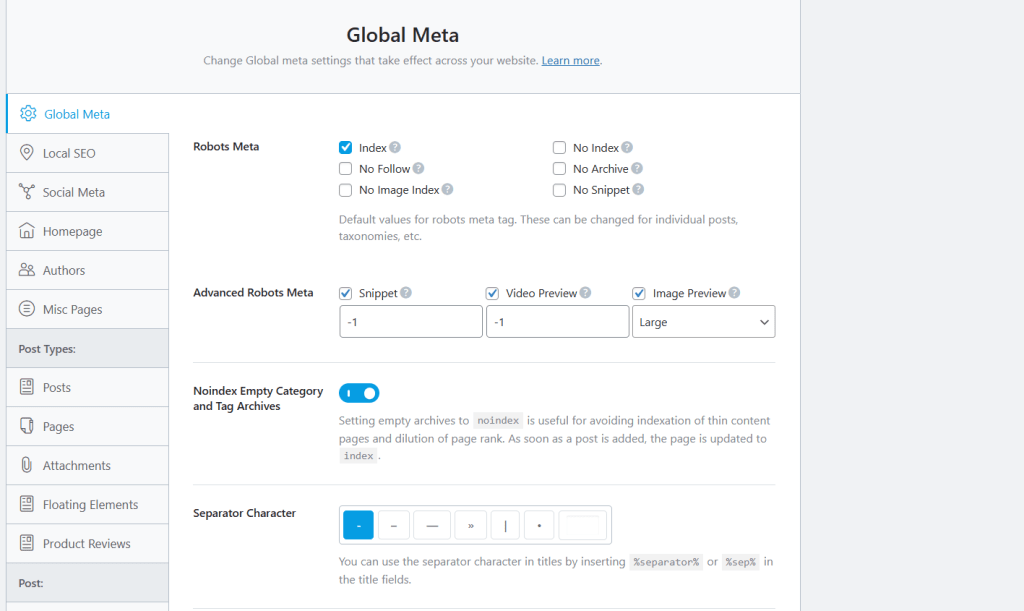
Once RankMath is set up, I use it whenever I write or edit an article:
- Focus Keyword: In the WordPress editor, I scroll to the RankMath box and enter my main keyword for the article. For example, if I’m writing about “Rank Math SEO setup,” that’s my focus keyphrase. RankMath immediately analyzes the content for that keyword.
- Follow the Suggestions: RankMath gives real-time tips in the editor. It checks keyword density, meta title/description, readability, headings, and more. I follow its simple recommendations: include the keyword in the title and first paragraph, add related terms in subheadings, etc. (But I don’t go crazy stuffing keywords, just natural use, as RankMath suggests.) The plugin’s score (up to 100) is a handy guide, but it’s not about perfection.
- Write Good Meta Titles and Descriptions: I make sure each post has a clear title and meta description that include the keyword. RankMath shows a preview of how this looks in Google. Clear titles and descriptions help both SEO and encourage people to click. For example, a title that includes the keyword and entices curiosity often has higher click-through.
- Structure with Headings: I use H2 and H3 headings logically (breaking up content into sections). This not only helps readers but also lets Google see the main topics of the page. RankMath’s analysis considers your heading structure. For instance, if I cover “RankMath free plugin tips” and “RankMath SEO pro features” in one article, I make them H2 and H3 so search engines know these are key subtopics.
- Internal Linking with Rank Math: Whenever possible, I link to other posts on my blog. RankMath’s content analysis often suggests relevant posts, making internal linking with Rank Math easier. This “hub and spoke” model builds topical authority and makes navigation easier for users and search bots. For example, a detailed tutorial might link back to a broader guide (and vice versa).
- Images: As mentioned, every image gets an ALT text. Also, I ensure the image file names contain relevant words (which RankMath will use for ALT suggestions). If I’ve already added content, I sometimes update older posts by adding missing ALT text or improving descriptions to boost SEO impact.
- Clean URLs: I keep my permalinks short and keyword-rich (no random numbers or dates). RankMath lets me edit the slug easily in the editor. For example, if my post is about recipe plugins, I might shorten the URL to /wordpress-recipe-plugins rather than a long auto-generated link. Shorter URLs with the main keyword help SEO and readability.
- Updating Old Posts: Periodically, I update older content. After making changes, I often resubmit the sitemap in Google Search Console (or use a tool like IndexNow) so Google knows to recrawl those pages. This brings fresh value to evergreen content and can give it a rankings boost.
When I do all of the above consistently, RankMath usually shows a high SEO score (I’ve even hit 100/100 on some posts). But remember: that score is just a guide. Even a score in the 90s with green checks on the main items is strong. Certain items like Content AI suggestions can lower the score, but that’s fine. Google cares more about helpful, clear content than a perfect plugin score.
My 6 Steps to Score 100/100 (Consistently)

- Write a clear title and meta description with the main keyword: Make them concise and enticing. RankMath previews how they look in Google.
- Use H2/H3 headings with related terms: Break up content logically so Google sees the structure. For example, use subtopics that include variations of your keyword.
- Add internal links to other posts on your site: This builds authority and keeps readers browsing. (RankMath even suggests related posts to link, helping with internal linking.)
- Give images proper ALT text and descriptive file names: RankMath’s Image SEO tool can auto-generate ALT text from the file name, so name images with SEO in mind.
- Keep URLs short, clean, and keyword-rich: Use RankMath to edit the slug. For example, change a long auto-link to something like /rankmath-guide.
- Update older posts occasionally and resubmit to Google: Fresh content and updated stats keep your site relevant. After major edits, hit Google Search Console or IndexNow to prompt a re-index.
Doing these basics consistently has helped me hit 100 in RankMath Free, and more importantly, it improved my actual rankings. (Again, note: a score above 90 with green checks on titles, meta, headings, links, and images is already strong. Certain optional items like Content AI suggestions can drop the score, but that’s okay.) Google rewards content that answers questions clearly, so keep that as your focus.
Keyword Research and Content Planning
RankMath is great for on-page SEO, but remember: great content and planning are the real keys. Here’s how I plan content without paid tools:
- Choose One Main Keyword: For each article, pick one main topic. Ask: What is the searcher really looking for? For example:
- If I’m focusing on “Rank Math Free workflow,” it’s likely Informational (people want a guide).
- “Rank Math Pro pricing” is probably a Commercial query (they might buy).
By matching your content format to intent (guide, review, list), you meet what people expect.
- Find Supporting Keywords: Instead of writing dozens of posts for similar queries, I add related terms into the same article. This makes content richer and covers more search intent. I look for synonyms or related questions:
- Use Google Autocomplete (type a phrase and see suggestions). For example, typing “free SEO plugin for WordPress” shows what people commonly ask.
- Check People Also Ask boxes on Google, or related questions on forums like Quora or Reddit. These often highlight long-tail queries.
- Check Google Search Console for queries I already rank for (RankMath’s link to Search Console makes this easy).
- Use Google Keyword Planner (free) for broad ideas. It suggests search volume and related keywords.
- Avoid Keyword Cannibalization: I never reuse the exact same main keyword for multiple posts. If two posts target the same phrase, they compete with each other. Instead, I map out my content in a simple table or mind map: each main keyword, supporting keywords, content type, and where it fits on the site. This mini content plan prevents overlap. If two ideas are too similar, I either merge them or choose one variation.
- Plan Internal Links: Once I know my topics, I decide how they link. Typically, a big “pillar” post will link to smaller detailed tutorials, and those tutorials link back to the pillar. This hub-and-spoke linking helps Google understand your site’s structure and helps users find relevant info. I write out which posts should link to each other as I plan. RankMath’s “Internal Link suggestions” tool can help me add these links as I write.
Why Content Quality and Consistency Matter
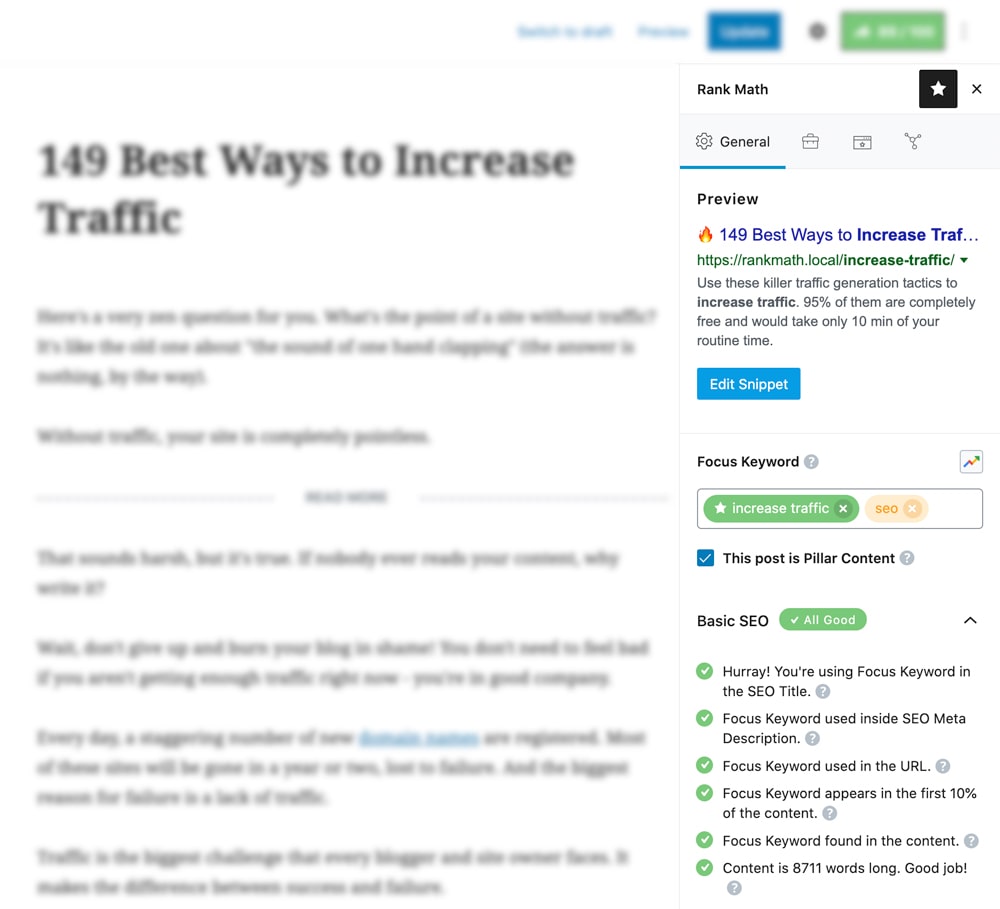
It’s easy to get caught up in plugin scores or quick fixes, but the real game is content. A perfect RankMath score won’t override weak content. Google is smart, because it rewards content that is useful, clear and matches search intent. In other words:
- Write helpful, clear content: Answer the question fully. If you were the searcher, what would you want to know?
- Match search intent: If people are looking for a step-by-step guide, give them exactly that, not a sales pitch. If they want a list of tools, format it as a list.
- Focus on user experience: Make it easy to read with headings, bullets, and images. Break up text into paragraphs (like we’re doing here). Use bullet lists and numbered steps where helpful – readers (and search engines) appreciate it.
- Be consistent: Regularly publish and update content. The “garden” analogy fits: starting a blog is like planting seeds. It takes time and care (consistent effort) for things to grow, but eventually you’ll see blooms. SEO is a marathon, not a sprint.
Think of RankMath Free as your reliable sidekick. It sets the foundation, but you still need the building blocks (your content) on top of it.
Free vs. Pro: What You Get (2025)
Do I really need RankMath Pro? Here’s my take. RankMath Free covers about 80% of what most bloggers need. It has these useful features at no cost:
- On-page SEO analysis and score (up to 100) for unlimited posts.
- Basic Schema Markup (Article, FAQ, HowTo, etc.) built into the blocks.
- XML sitemaps and robots.txt control (auto-generated and customizable).
- Redirections (301, 302, 307) with a redirect manager.
- Automatic Image ALT text (Image SEO features) for better image ranking.
- Integration with Google Search Console (for free accounts).
- Community support and online documentation.
- Internal Link suggestions, helps you find related posts to link (a free SEO tool within RankMath).
RankMath Pro adds advanced features like:
- Additional schema types (Product, Course, Video, etc.).
- Built-in keyword rank tracking and advanced Content AI suggestions.
- Video sitemap, local SEO modules, and more detailed reports.
- Premium support and multi-site management modules for agencies.
- The RankMath Pro plugin includes tools like WooCommerce SEO, Knowledge Graph, etc.
As for rank math pricing, Pro plans start at about $6.99/month for a single site (Business plan) and go up (Agency plans around $20–$50+). If you run multiple sites or want those extra bells and whistles, it might be worth it. You can always download Rank Math Pro from the site later if you decide to upgrade.
But honestly, for a single blog on a budget, the free version alone feels like one of the best SEO tools for WordPress I’ve ever used. I’ve grown my blog without paying anything, and I still feel I have all the tools I need. You only need to upgrade if you want things like built-in Content AI, detailed analytics or managing many sites.
My View: RankMath Free is already better than many premium plugins at a basic level. It offers tons of features at no cost. The Pro is there if and when you need it, but don’t feel pressured to upgrade early. Focus on content and basics first, since those have the biggest impact.
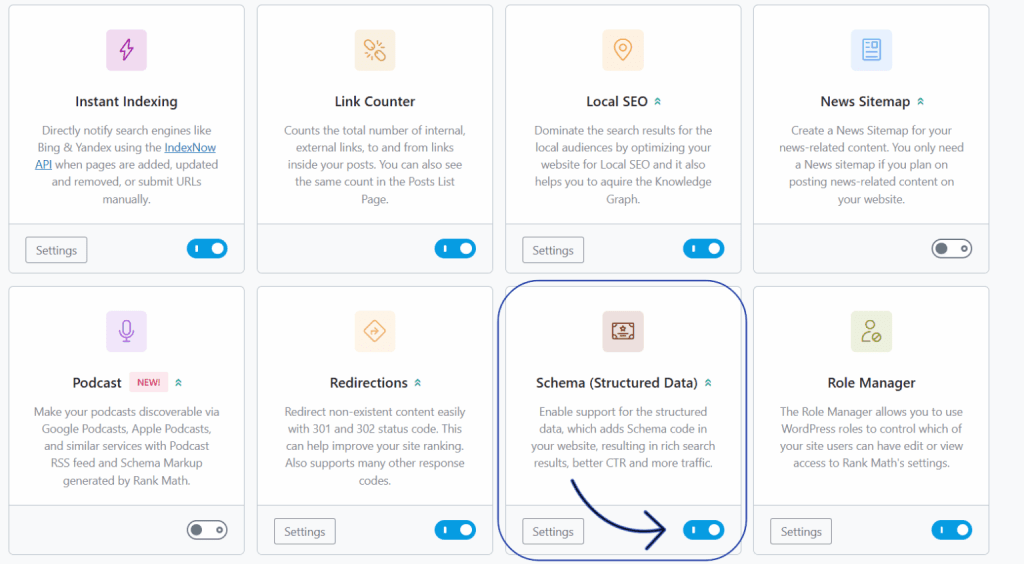
Bonus Tips and Key Takeaways
- Use free keyword research: Don’t buy expensive tools starting out. I rely on Google Autocomplete, People Also Ask, Search Console, and the free Keyword Planner to find keywords. These are good enough for most niche blogs.
- Enable only key modules: After installing RankMath Free, go to RankMath → Dashboard and toggle on what you actually need. A lighter setup keeps your site speedy.
- Regular updates: Keep RankMath updated to get new features and fixes. Also update your posts now and then (especially ones that rank well) to add freshness.
- Schema for rich snippets: Make your FAQs, HowTos, and products eligible for rich results. This can land you in Google’s AI Overviews and other rich features. (RankMath’s interface makes schema easy, even if you have to explore a bit or see rank math schema settings explained in the docs.)
- Check technical SEO: Use RankMath to submit your sitemap to Google, set canonical URLs, and scan for 404 errors. Fix any issues promptly so nothing blocks your SEO.
- Focus on people: Always ask “Is this content helpful and easy to read?” If yes, then your SEO foundation is strong. Don’t write for the plugin; write for your readers. RankMath is guiding you on SEO, but you are ultimately the content creator.
Remember, internal linking with RankMath’s tools and creating a solid content plan make a huge difference. Link related posts and build a clear site structure. That hub-and-spoke model tells Google your site is organized and helps readers navigate.
RankMath Free works as a solid foundation for SEO. With a good hosting and consistent content, you can rank well without ever paying for Pro. In my experience, a fast host and good content matter way more than chasing a perfect plugin score.
Final Thoughts
RankMath has been my SEO sidekick for years. It’s user-friendly, guides you through setup without needing to be a tech wizard, and gives you one dashboard for all things SEO. In 2025, SEO has evolved with AI and new features, but RankMath Free keeps up (it now supports AI Overviews, new schema types, and more). You don’t need a flashy premium plan because I’ve seen real results with just the free version.
If you’re starting out, download RankMath Free and try this workflow. Keep your paragraphs short, use clear headings, and focus on one keyword at a time. Remember: helpful content and consistency will grow your blog over time. Good luck and happy optimizing!




